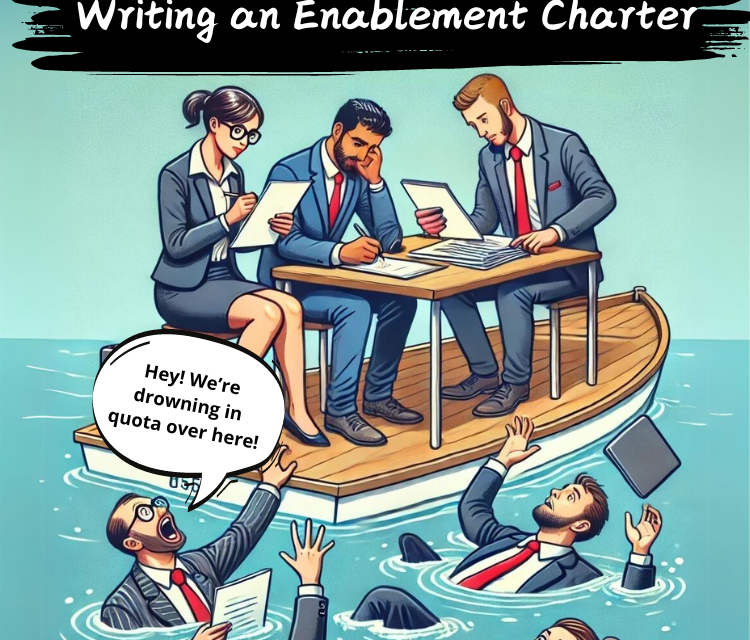
Why Sales Enablement Charters are B.S. (and how to do better)

Have you ever seen an Enablement conference keynote or webinar titled “How Our Enablement Charter Saved the Organization”?
Me neither.
And yet, we spend an absurd amount of time and effort finding templates, customizing them, meeting with stakeholders, explaining (for the tenth time) what exactly Revenue Enablement does, and getting all of our stakeholders to literally sign on the dotted line… only to end up with the same problems we had before.
We fight fires.
We become fixers of broken things.
Sellers still think of us as harbingers of pointless busywork (training), instead of strategic partners in their success.
As a profession, we in enablement give far too much stock to these charters. We cling to them like they’re some magical shield that will save us from the chaos of stakeholder requests. We find the perfect template, make it our own, and get the “buy-in” we so desperately covet.
And yet, the same issues arise—the very ones we wrote a charter to save us from in the first place.
So why don’t I like charters? Here’s where I’ve seen them fail, and how we can fix it.
1. Charters Are Too Complex, and Not Memorable
Frankly, enablement charters are about as exciting as an insurance policy. They outline objectives, KPIs, and timelines with the kind of sterile professionalism that makes HR handbooks seem like light reading.
We create this document and expect our stakeholders to remember 10 SLAs, three new processes, and to use the project management board we created.
Unfortunately, the six other cross-functional departments (think product marketing, engineering, legal, etc.) that work with or support sales also have their own expectations, processes, SLAs, and procedures that are supposed to be followed.
Yes, it’s important to have boundaries and set expectations around what we do and don’t do. But to provide great service to our internal customers, Enablement needs to put those boundaries within the flow of work, simplify them as much as possible, and be willing to gently re-direct those who knowingly (or unknowingly) skirt the process. Most of our internal customers WANT to do the right thing and follow the process, but if the “right thing” is buried in a 10-page document, they will take the path of least resistance (like a random Slack message at 10 p.m.).
2. Charters Assume Signing It Is the Same as Implementing It
Signing the charter feels like crossing a finish line. The meetings, discussions, and edits are finally over, and everyone’s agreed on the direction. Unfortunately, that signature is just the beginning, not the end. Too often, once the ink dries, everyone moves on as if the job is done. Spoiler: It’s not.
Charters don’t implement themselves, people do. Leadership buy-in does not equal change. The actual hard work comes after the signatures—the training, the coaching, the habit-changing, the ongoing support. Without that, the charter is nothing but a fancy document forgotten faster than last week’s new product release.
So what do we do? Treat the charter as a living document that requires constant upkeep and reinforcement. This isn’t “set it and forget it.” It’s about ongoing engagement with your sales team. Hold your boundaries, and hold leadership accountable to the standards everyone agreed on. When we lack the backbone (or agency) to enforce the boundaries we set, charters quickly become a stale repository filled with good intentions.
3. Charters Tell Others What We Do, Instead of Showing Them
One of the biggest problems with charters is that they’re great at documentation and definition, but the time spent on a charter is time spent on something that won’t have a direct, tangible impact on the sales team or the bottom line. Charters are often filled with lofty descriptions of how the enablement team will align sales and marketing, improve rep performance, and drive results. Your salespeople don’t need more words. They need your help.
This reliance on documentation creates a disconnect. Stakeholders might nod their heads in meetings, but they don’t really see the value of enablement. Sales reps, in particular, won’t be impressed by another document telling them what you plan to do—they want tangible help that makes their jobs easier right now. You can write all the charters you want, but if you’re not actively showing people how you’re making an impact, the charter will quickly become irrelevant.
Make your AEs’ day-to-day easier. Remove roadblocks. Provide data-backed insights into behaviors, processes, or roadblocks that block revenue and fix them. When we show people what enablement does through our actions, it’s far more effective than any charter we could ever write.
































